
West Carroll Parish is a parish located in the northeastern part of the U.S. state of Louisiana. As of the 2020 census, the population was 9,751. The parish seat is Oak Grove. The parish was founded in 1877, when Carroll Parish was divided.

Madison Parish is a parish located on the northeastern border of the U.S. state of Louisiana, in the delta lowlands along the Mississippi River. As of the 2020 census, the population was 10,017. Its parish seat is Tallulah. The parish was formed in 1839.

Lake Providence is a town in, and the parish seat of, East Carroll Parish in northeastern Louisiana. The population was 5,104 at the 2000 census and declined by 21.8 percent to 3,991 in 2010. The town's poverty rate is approximately 55 percent; the average median household income is $16,500, and the average age is 31.
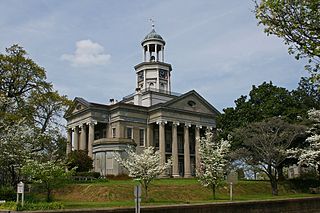
Vicksburg is a historic city in Warren County, Mississippi, United States. It is the county seat. The population was 21,573 at the 2020 census. Located on a high bluff on the east bank of the Mississippi River across from Louisiana, Vicksburg was built by French colonists in 1719. The outpost withstood an attack from the native Natchez people. It was incorporated as Vicksburg in 1825 after Methodist missionary Newitt Vick. The area that is now Vicksburg was long occupied by the Natchez Native Americans as part of their historical territory along the Mississippi. The first Europeans who settled the area were French colonists who built Fort Saint Pierre in 1719 on the high bluffs overlooking the Yazoo River at present-day Redwood. They conducted fur trading with the Natchez and others, and started plantations. During the American Civil War, it was a key Confederate river-port, and its July 1863 surrender to Ulysses S. Grant, along with the concurrent Battle of Gettysburg, marked the turning-point of the war.

Oak Alley Plantation is a historic plantation located on the west bank of the Mississippi River, in the community of Vacherie, St. James Parish, Louisiana, U.S. Oak Alley is named for its distinguishing visual feature, an alley or canopied path, created by a double row of southern live oak trees about 800 feet long, planted in the early 18th century — long before the present house was built. The allée or tree avenue runs between the home and the River. The property was designated a National Historic Landmark for its architecture and landscaping, and for the agricultural innovation of grafting pecan trees, performed there in 1846–47 by an enslaved gardener. It was first known as Bon Séjour.

Paul Octave Hébert was a soldier and politician who served as 14th Governor of Louisiana from 1853 to 1856. A veteran of the Mexican-American War, he later served as a brigadier general in the Confederate States Army.

The Battle of Goodrich's Landing, Louisiana, was fought on June 29 and June 30, 1863, between Union and Confederate forces during the American Civil War. The Confederates attacked several Union regiments, who were composed mostly of black soldiers, in an attempt to disrupt the campaign at Vicksburg, Mississippi.

Joseph Eugene Ransdell was an attorney and politician from Louisiana. Beginning in 1899, he was elected for seven consecutive terms as United States representative from Louisiana's 5th congressional district. He subsequently served for three terms in the United States Senate from Louisiana before being defeated in the 1930 Democratic primary for the seat by Governor Huey Long.
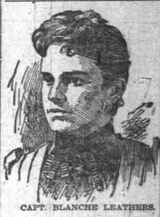
Blanche Douglass Leathers was the first woman master and a steamboat captain on the Mississippi River in the late 19th and early 20th centuries. Her nicknames include "little captain," the "angel of the Mississippi" and the "lady skipper."
Disharoon's plantation was located in Tensas Parish, Louisiana and was used as a steamboat landing on the Mississippi River by Union Army General Ulysses S. Grant during the American Civil War.

Milliken's Bend is an extinct settlement that was located along the Mississippi River in Madison Parish, Louisiana, United States for about 100 years. In its heyday, the village had a boat landing, two streets of businesses, residences, churches, a four-room schoolhouse, a ferryman, and roads connecting it to Lake Providence, and Talluha.

Rodney is a ghost town in Jefferson County, Mississippi, United States. Most of the buildings are gone, and the remaining structures are in various states of disrepair. The town floods regularly, and buildings have extensive flood damage. The Rodney History And Preservation Society is restoring Rodney Presbyterian Church. Damage to the church's facade from the American Civil War has been maintained as part of the historical preservation, including a replica cannonball embedded above the balcony windows. The Rodney Center Historic District is on the National Register of Historic Places.
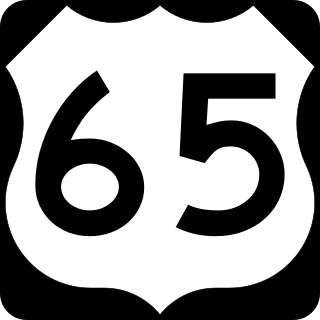
U.S. Highway 65 (US 65) is a part of the United States Numbered Highway System that spans 966 miles (1,555 km) from Clayton, Louisiana to Albert Lea, Minnesota. Within the state of Louisiana, the highway travels 100.77 miles (162.17 km) from the national southern terminus at US 425/LA 15 in Clayton to the Arkansas state line north of Lake Providence.
The 1st Louisiana Battery Light Artillery (African Descent) was organized at Hebron's Plantation, Missouri, November 6, 1863. Attached to 1st Brigade, U.S. Colored Troops, District of Vicksburg, to April, 1864. On duty at Goodrich Landing and Vicksburg till April, 1864. Designation of Battery changed to Battery "C", 2nd U.S. Colored Light Artillery, April 26, 1864.

Bruinsburg is an extinct settlement in Claiborne County, Mississippi, United States. Founded when the Natchez District was part of West Florida, the settlement was one of the end points of the Natchez Trace land route from Nashville to the lower Mississippi River valley.
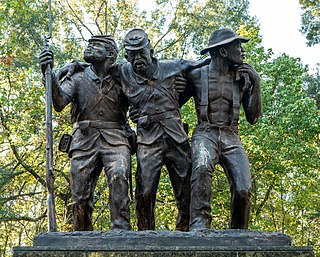
The 51st United States Colored Infantry Regiment was an infantry regiment composed of African-American troops recruited from Mississippi that served in the Union Army during the American Civil War. Initially formed in the spring of 1863 as the 1st Regiment Mississippi Volunteer Infantry (African Descent), the Regiment took part in fierce fighting at the Battle of Milliken's Bend, served on garrison duty in Louisiana, and then took part in the Battle of Fort Blakely, the last major battle of the war.
Colonel Preston Withers Farrar was an American lawyer and Whig politician. He was the Speaker of the Louisiana House of Representatives from 1848 to his death in 1850. He also served in both houses of the Mississippi Legislature.
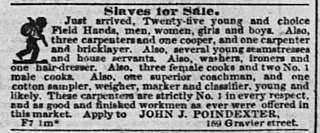
John Jenkins Poindexter was an American slave trader, commission merchant, school commissioner, and steamboat master of Louisiana and Mississippi. He served in the Mexican-American War as a junior officer in the Mississippi Rifles. The historic John J. Poindexter House in Jackson, Mississippi, was commissioned for the young Poindexter family and designed in the 1840s by architect William Nichols.
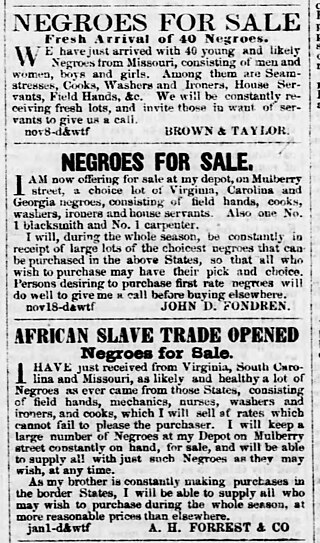
Aaron H. Forrest was one of the six Forrest brothers who engaged in the interregional slave trade in the United States prior to the American Civil War. He may have also owned or managed cotton plantations in Mississippi. He led a Confederate cavalry unit composed of volunteers from the Yazoo River region of Mississippi during the American Civil War. He died in 1864, apparently from illness.
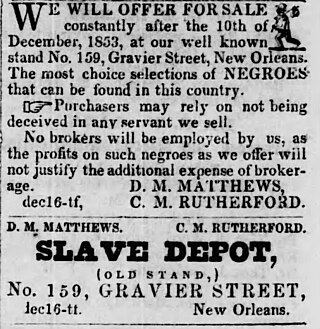
Calvin Morgan Rutherford, generally known as C. M. Rutherford, was a 19th-century American interstate slave trader. Rutherford had a wide geographic reach, trading nationwide from the Old Dominion of Virginia to as far west as Texas. Rutherford had ties to former Franklin & Armfield associates, worked in Kentucky for several years, advertised to markets throughout Louisiana and Mississippi, and was a major figure in the New Orleans slave trade for at least 20 years. Rutherford also invested his money in steamboats and hotels.




















